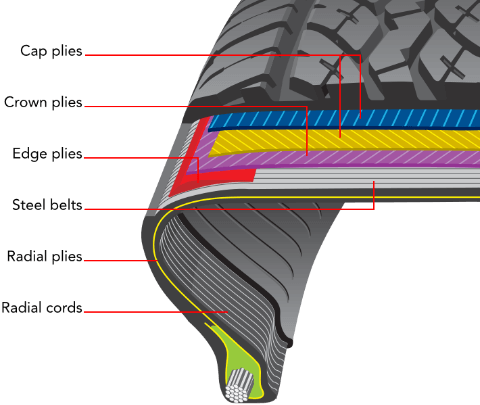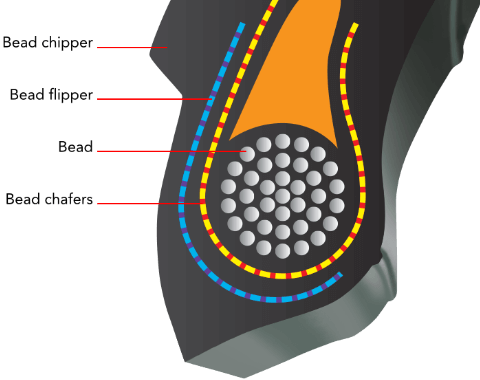
Tire construction
Many things go into making a tire. They are designed to provide reliable support, handling and performance against the rigors of the road. The most common type of tire is the radial tire. Since the first rolled off the production line in 1946, consumers have demanded them for their superior handling, ride, tread wear and fuel efficiency.
TIRE INNER LINING
The inner liner is the first layer of the inside of a tire. It is designed to help prevent air loss.
TIRE BEADS AND BEAD SLIDERS
The beads of a tire form the contact point between the tire and the wheel. They are made of high tensile strength steel wires and are surrounded by a hardened rubber compound. They guarantee a tight seal between the wheel and the tire. The beads rest between the bead and the tire’s body ply, preventing the bead wires from damaging the tire carcass and improving the tire’s handling by making the sidewall above more responsive.
TIRE SIDEWALK
The sidewall of a tire performs many different and important functions. Provides protection to the inner layers against abrasions and cuts. Manufacturers can vary the handling characteristics and load capacities of a tire by changing the construction of the sidewalls. For example, a stiffer sidewall may result in more predictable handling but will compromise road quality.
The sidewall is also the location of important tire information, such as size, load and speed rating, and maximum air pressure.
TIRE HOUSING
The tire carcass is the internal structure which is composed of radial ply, steel belt package and top ply.
RADIAL TIRE RIM
The radial ply is one of the most important layers of the tire carcass. It consists of rubber-bonded cords that run around the circumference of the tire at 90 degrees to the direction of travel of the tire. Radial construction helps absorb shock from driving surfaces and allows the tread and sidewalls to function independently. This reduces tread flex, friction and cross-slip, leading to greater fuel efficiency, more responsive handling and longer tread life.
TIRE BELT PACKAGE
The tire belt pack performs multiple functions, including protecting the tire casing from road damage and creating a flat area for the tire tread. The belt pack is constructed of woven strands of high-strength steel fibers, which are bonded to rubber. The belt package improves the rigidity of the tires while remaining flexible enough to absorb bumps in the road.
TIRE LAYER
Protective layers are used in high-performance tires and higher quality all-season tires. The top layer combats centrifugal forces and contains the belt pack maintaining the tire’s shape at high speeds, leading to better braking and handling.
TIRE ROLLING AREA
The tread area of a tire is made up of different characteristics that work cooperatively to provide traction, handling and ride feel. These characteristics vary depending on the intended use of the tire.
Circumferential grooves are channels that run the entire length of the tire and help reduce hydroplaning by evacuating water from the tread surface. They also help reduce tire noise by allowing air to pass underneath.
Side grooves are channels that run 90 degrees from the direction of travel, improving traction by removing water, snow and mud from the tread design.
The sipes are thin grooves to improve grip in wet and icy conditions.
Solid or semi-solid ribs are tread block elements that extend uninterruptedly around the circumference of the tire. Improves handling performance and traction in dry weather. Large individual tread blocks increase dry weather traction by placing more rubber in contact with the driving surface.
The shoulder characteristics of a tire can vary quite a bit. Some tires use a solid shoulder to reduce road noise and improve cornering response. Others use grooves to channel water, snow and mud. Some may feature aggressive bumps that add grip in off-road driving situations.
One of the key traction characteristics of a tire is the rubber compound.
TIRE TREADING COMPOUND
One of the most important components of a tire tread is the tread compound. The compound varies from one tire to another depending on the intended use of the tire.
For example, winter tires are made with a compound designed to remain flexible when the temperature drops below 45 degrees. This helps ensure traction even in harsh winter conditions.
On the other hand, summer tires are designed to operate at very high temperatures and very high speeds. They lose functionality in colder temperatures.
All-season tires attempt to satisfy a broad set of consumer needs. The compound of an all-season tire is generally designed to provide reliable traction in dry, wet, and light snow conditions. It is also designed to offer more resistance to wear. Tread compound is one of the most difficult and complex tire characteristics to design due to the often conflicting nature of tire performance demands.
Please refer to the diagrams below to better understand the elements that make up a tire.
TIRE SOLE

Tread area (contact patch) – The part of the tire that comes into contact with the road. The type of tread is distinguished by the design of its ribs and grooves.
Shoulder: The part of a tire where the sidewall and tread meet. Certain tire designs feature shoulder blocks for better traction.
Grooves: The space between two adjacent tread ribs; Also called tread grooves.
Sipes: Cuts in the tread blocks for water evacuation and sharp edges on road surfaces.
Tread Blocks – Form the tread pattern for wear resistance, stability and traction.
Tire Rib: Part of the tire tread pattern created by grooves that run circumferentially around the tire.
BELT PACK

Cover Layers: Maintains the shape of the tread contour at high speeds to reduce heat buildup and impart rigidity to the tread for better grip.
Crown Plies: Provide centrifugal and lateral rigidity to the tire, while allowing the tire to flex enough for a comfortable ride.
Rim Plies: Reinforces the tire shoulder shape to improve handling and grip.
Steel belts: Strengthens the tread region, providing flexibility and walking comfort.
Radial Ply: Tire construction where the body cords run at 90 degrees to the centerline of the tread.
Radial Laces – Run along the sidewall to allow for spring-like flexibility as a way to provide walking comfort.
TIRE BEAD

Bead chipper: Protects the bottom side wall
Bead Flipper – Helps keep bead in place
Bead: The beads are responsible for holding the tire firmly against the wheel rim.
Bead Chafers: Protects wire bead components.
Do you have questions? Do you need help choosing the right tire? We can help you choose which tire is right for you with Tread well, our intuitive and simple tire buying guide. Simply enter your vehicle, your travel and road conditions, and other important factors to get the perfect tire recommendation!
Instalación de neumáticos
Nuestros técnicos expertos proporcionan instalaciones de neumáticos precisas y eficientes, garantizando un rendimiento y seguridad óptimos para su vehículo. Servicios de equilibrio
Controles de presión
Servicios de rotación
Experimente una conducción suave y controlada con nuestros servicios profesionales de alineación de ruedas, mejorando la estabilidad de su vehículo y la longevidad de los neumáticos.
Servicios de ajuste
Calibración de precisión
